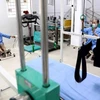Vietnam is one of nine countries in the West Pacific region with alarming rates of hepatitis B virus (HBV) with 10-20 percent of the population (10-16 million people) living with HBV, according to the World Health Organisation (WHO).
It is estimated that a Vietnamese HBV patient spends about 60-200 million VND (3,000- 9,500 USD) a year on medical treatment expenses to cure the disease, which can last up to two years.
According to the Vietnam Association for the Study of Liver Diseases, around 10,000 Vietnamese people die every year from cirrhosis complications and liver cancer. Efforts to eliminate the virus annually costs the country about 660 trillion VND (31.4 billion USD).
The General Department of Preventive Medicine under the Ministry of Health (MOH) emphasised the disease can be life-threatening; serious and fatal liver infections have resulted from HBV. It can cause chronic infections and puts people at high risk of death from cirrhosis and liver cancer.
Some 25 percent of HBV patients will develop cirrhosis or liver cancer if they do not receive timely diagnosis and treatment.
Notably, 100 percent of liver cancer in children is caused by HBV. The virus is mainly spread from mother to child at birth (peri-natal transmission), exposure to infected blood (horizontal transmission) and unprotected sexual intercourse.
The MOH has warned that there is no specific treatment for acute HBV currently available and the HBV vaccine is the mainstay of HBV prevention.
The HBV vaccine is considered a safe and highly effective method to prevent the disease; rare side effects include pain or fever but no severe consequences have been recorded, according to the US Centre for Disease Control and Prevention (CDC).
The WHO recommends that all infants receive the HBV vaccine as soon as possible postpartum, preferably within 24 hours for best results.
Statistics from the WHO reveal that over 350 million people are diagnosed with chronic HBV and about one million die as a result each year. Although everyone is vulnerable to HBV, children less than six years of age are most likely to develop chronic infections.-VNA
It is estimated that a Vietnamese HBV patient spends about 60-200 million VND (3,000- 9,500 USD) a year on medical treatment expenses to cure the disease, which can last up to two years.
According to the Vietnam Association for the Study of Liver Diseases, around 10,000 Vietnamese people die every year from cirrhosis complications and liver cancer. Efforts to eliminate the virus annually costs the country about 660 trillion VND (31.4 billion USD).
The General Department of Preventive Medicine under the Ministry of Health (MOH) emphasised the disease can be life-threatening; serious and fatal liver infections have resulted from HBV. It can cause chronic infections and puts people at high risk of death from cirrhosis and liver cancer.
Some 25 percent of HBV patients will develop cirrhosis or liver cancer if they do not receive timely diagnosis and treatment.
Notably, 100 percent of liver cancer in children is caused by HBV. The virus is mainly spread from mother to child at birth (peri-natal transmission), exposure to infected blood (horizontal transmission) and unprotected sexual intercourse.
The MOH has warned that there is no specific treatment for acute HBV currently available and the HBV vaccine is the mainstay of HBV prevention.
The HBV vaccine is considered a safe and highly effective method to prevent the disease; rare side effects include pain or fever but no severe consequences have been recorded, according to the US Centre for Disease Control and Prevention (CDC).
The WHO recommends that all infants receive the HBV vaccine as soon as possible postpartum, preferably within 24 hours for best results.
Statistics from the WHO reveal that over 350 million people are diagnosed with chronic HBV and about one million die as a result each year. Although everyone is vulnerable to HBV, children less than six years of age are most likely to develop chronic infections.-VNA



















